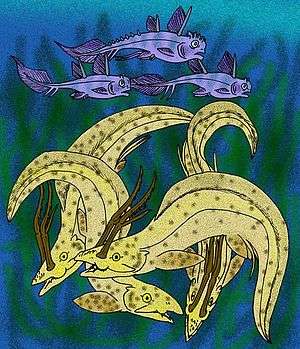Harpagofututor
| Harpagofututor Temporal range: Mississippian | |
|---|---|
 | |
| Echinochimaera (top) and Harpagofututor (bottom) | |
| Scientific classification | |
| Kingdom: | Animalia |
| Phylum: | Chordata |
| Subphylum: | Vertebrata |
| Infraphylum: | Gnathostomata |
| Class: | Chondrichthyes |
| Order: | Chondrenchelyiformes |
| Genus: | Harpagofututor |
| Species: | H. volsellorhinus |
Harpagofututor is an extinct genus of cartilaginous fish from the Mississippian of North America.
It was an eel-shaped fish with almost no scales. About eight inches (20 cm) long, it swam with some help from its fins, but also relied on whole-body locomotion to move. The fish also had teeth sufficient for eating shellfish.[1]
Harpagofututor is thought to be related to the cochliodonts, chimaeroids, and Chondrenchelys problematica.[1]
The fish was discovered in the 1980s in Montana's Bear Gulch area by Adelphi University palaeontologist Richard Lund, who has been exploring the limestone formations of the region since 1969. [2] [3] The area was thought to be the location of a shallow bay. Fish remains are found throughout the area. Further examinations of the soft tissue pigments of these fossilized remains led to more information about the fish and information about its internal organs, including its reproductive system. [4]
Sources
- Aquagenesis: The Origin and Evolution of Life in the Sea by Richard Ellis
- The Rise of Fishes: 500 Million Years of Evolution by John A. Long
References
- 1 2 Bear Gulch - Harpogofutor volsellorhinus
- ↑ Lund, Richard. "Harpagofututor volsellorhinus New Genus and Species (Chondrichthyes, Chondrenchelyiformes) from the Namurian Bear Gulch Limestone, Chondrenchelys problematica Traquair (Visean), and Their Sexual Dimorphism," Journal of Paleontology, Vol. 56, No. 4, July 1982, pp. 938-958.
- ↑ Bear Gulch - About Richard Lund
- ↑ Grogan, Eileen D. and Richard Lund. "Soft Tissue Pigments of the Upper Mississippian Chondrenchelyid, Harpagofututor volsellorhinus (Chondrichthyes, Holocephali) from the Bear Gulch Limestone, Montana, USA," Journal of Paleontology, Vol. 71, No. 2, March 1997, pp. 337-342.